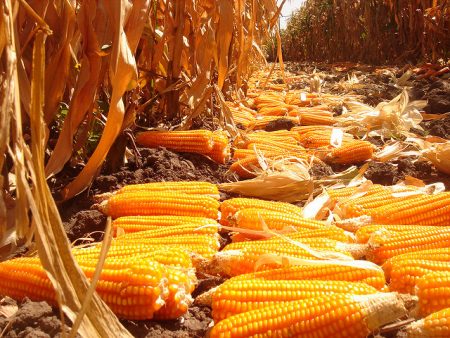
EL BATAN, Mexico (CIMMYT) – Maize nutritionally enhanced with vitamin A can bring significant health benefits to deficient populations, but recent modeling studies in Zambia suggest that its impact is being cut short by the low retention of provitamin A carotenoids – a naturally occurring plant pigment also found in many orange foods that the body then converts into vitamin A – during storage and postharvest grain loss.
Up to 30 percent of grain is lost in African countries when maize is stored using common storage methods, such as artisanal silos or woven bags, due mostly to insect, rodent or fungi infestations and accumulation of poisonous chemical compounds called mycotoxins, which are produced by certain fungi.
A recent study evaluated the impact of carotenoid retention in orange maize using different storage methods to assess the most efficient way to store grain without losing vitamin A carotenoids. The researchers specifically evaluated how hammer and breakfast meal – the two most widely consumed grains in Zambia – age in metal silos, multilayer polyethylene and common woven bags, as well as single and multilayer polyethylene bags.
The researchers found significant differences between grain storage methods after 6 months of storage. Across all methods, hammer meal retained more carotenoid than breakfast meal after 4 months, though there was no difference in provitamin A carotenoid loss when using single and multilayer polyethylene bags.
Potential contribution of stored orange maize to the estimated average provitamin A requirement of children and women was around 25 percent – 26.5 and 24.3 percent for children and women, respectively – suggesting that orange maize meal can provide significant amounts of provitamin A to Zambian diets, even after 4 months of storage.
Read the full study “Carotenoid retention in biofortified maize using different post-harvest storage and packaging methods” and check out other recent publications from CIMMYT staff below.
- Economic benefits of climate-smart agricultural practices to smallholder farmers in the Indo-Gangetic Plains of India. 2016. Khatri-Chhetri, A., Aryal, J.P., Sapkota, T.B., Khurana, R. In: Current Science, v. 110, no. 7, p. 1251-1256.
- Effect of different mulching materials on maize growth and yield in conservation agriculture systems of sub-humid Zimbabwe. 2016. Mupangwa, W., Nyagumbo, I., Mutsamba, E.F. In: AIMS agriculture and food, v. 1, no. 1, p. 239-253.
- Effect of in situ moisture conservation practices on environmental, energetics and economic comparisons on maize + blackgram cropping system in dryland ecosystem. 2016. Jat, M.L., Balyan, J.K., Shalander Kumar, Dadhich, S.K. In: Annals of biology, v. 32, no. 2, p. 158-163.
- Effect of long-term tillage and diversified crop rotations on nutrient uptake, profitability and energetics of maize (Zea mays) in north-western India. 2016. Yadav, M.R., Parihar, C.M., Jat, S.L., Singh, A.K., Kumar, D., Pooniya, V., Parihar M.D., Saveipune, D., Parmar, H., Jat, M.L. In: Indian Journal of Agricultural Sciences, v. 86, no. 6, p. 743-749.
- Effectiveness and economics of hermetic bags for maize storage: results of a randomized controlled trial in Kenya. 2016. Ndegwa, M.K., De Groote, H., Gitonga, Z., Bruce, A.Y. In: Crop Protection, v. 90, p. 17-26.
- Carotenoid retention in biofortified maize using different post-harvest storage and packaging methods. 2017. Taleon, V., Mugode, L., Cabrera-Soto, L., Palacios-Rojas, N. In: Food chemistry, v. 232, p. 60-66.
- Characteristics of maize cultivars in Africa: How modern are they and how many do smallholder farmers grow? 2017. Tsedeke Abate, Fisher, M., Abdoulaye, T., Kassie, G., Lunduka, R., Marenya, P., Asnake, W. In: Agriculture and food security, v. 6, no. 30.
- CIMMYT Series on carbohydrates, wheat, grains, and health: carbohydrates, grains, and whole grains and disease prevention. Part IV. Cancer risk: lung, prostate, and stomach. 2017. Jones, J.M., Peña-Bautista, R.J., Korczack, R., Braun, H.J. In: Cereal Foods World, v. 62, no. 1, p. 12-22.
- CIMMYT Series on carbohydrates, wheat, grains, and health: carbohydrates and vitamins from grains and their relationships to mild cognitive impairment, Alzheimer’s disease, and Parkinson’s disease. 2017. Jones, J.M., Korczack, R., Peña-Bautista, R.J., Braun, H.J. In: Cereal Foods World, v. 62, no. 2, p. 65-75.
- Crossfire: ‘Private sector engagement in smallholder value chains’. 2017. Belt, J., Hellin, J. In: Practical Action Publishing, v. 28, no. 1-2.
 Nutrition, health and food security
Nutrition, health and food security